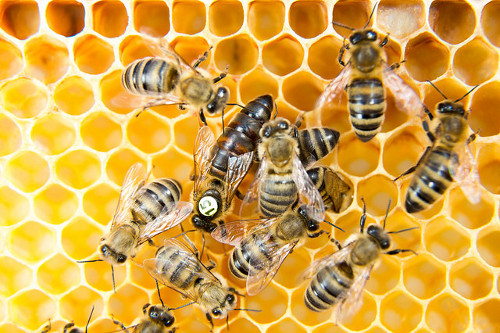
020 3404 5177

The most evident signs for wasps in the loft is spotting the nest itself anywhere nearby your loft, usually, it’s located under its roof. This happens most commonly during spring or summer months when wasp activity is greatest. A well-matured wasp nest may contain several thousand wasps and it’s not recommended that you do anything about it without asking for professional help or at least before preparing to remove it on your own.
The entrance to the nest may be located by close observation of where exactly the flying insects come out and get in. It’s vital to identify this place in the nest as it is the one that should be treated if/when necessary to do so.
The physical characteristics of the wasp nest depend mostly on the wasp species that have made the nest. If they are common wasps it may simply be a hole in the roof or the wall without any significant features.
During its initial stages, the size of a wasp nest is about the size of a tennis ball and becomes progressively bigger in time. It’s much easier to remove or replace a nest when it’s smaller in size. If ignored earlier in the year, and the wasp population becomes much larger, as well as the nest’s size, it’s removal becomes much harder. You will either need a professional wasp nest treatment service or a safe plan for its destruction.


If you have tried all possible ways to treat a wasp nest and have come to the conclusion to remove it on your own, this is fine as long as you follow a few simple rules. Check our recommendations and tips below and make sure not to ignore any of them. It’s not worth taking a risk at the cost of a much greater failure, which can result in getting injured by the wasps.
Stick to the advice, provided above and do not ignore any of the recommendations – it’s for your safety and for the sake of finally getting rid of the wasp nest in your loft. In case you find it really difficult to get the job done the way it should be completed, do not hesitate to call a professional pest control expert who will do wasp nest treatment for you.
The price for treating a wasp nest in London from your loft is usually fixed when the service is done by a professional pest control company. If there is a need for any additional charges, they will be added following the inspection. This means, before agreeing to have the job done, you will know how much it will cost you in advance.
Incorrect pest extermination companies may give you an hourly-based service, which in the end may turn out to be much more expensive at the cost in exchange for nothing.
If you want to make sure that the wasp nest will be treated from your loft for a fair price, without any hidden charges, don’t hesitate to contact us and get an instant quote for your wasp nest treatment.


Prevention is possible if measures are taken on time. When you spot a wasp anywhere around your property in London, mind that it’s there for reason and is certainly not just one. Try to observe its behaviour for a while and you will notice that it probably visits only a certain spot. This means it’s building a nest which can hardly be found without a proper inspection of the wasps’ behaviour and flying patterns. Removing it in time before it’s finished is one of the ways to prevent severe wasp infestations.
It’s also important to pay attention to other details such as food and beverage consumption outside the building. Foods and drinks rich in sugar and carbohydrates attract not just bees but wasps as well. If a person regularly leaves such tempting consumables nearby his loft or in the garden, a colony of wasps is highly possible to make a nest nearby – after all, their goal is to live in proximity to a food source. Check these additional tips on how to prevent a wasp nest in the loft:


An old wasp nest is one that has survived until the winter and throughout the whole year. When it is unfrozen in the next year’s spring, it will be ignored by the new colony of wasps as they prefer to make a new one instead of using an old wasp nest. This means you can ignore the old nest if you don’t find it unpleasant.
If you insist on removing the nest, however, you should the nest inside non-transparent bags, otherwise someone may get really scared at the sight of a person holding a wasp nest with his bare hands.
It’s not that hard to determine the type of the nest in your loft based on its specific features. Usually, people mistake a wasp nest for a beehive if they do not take a closer look. If there are hexagonal combs on the nest and is formed of yellow layers covered in wax, it most certainly a honey beehive. Bees maybe even more aggressive than wasps when approached or disturbed, so whatever the nest is, do not get too close to it without proper preparation. Look for any of the following signs if you have doubts whether it is a beehive or a wasp nest in your loft:

Generally, bees are considered to be a protected animal species. However, currently, in the UK they are not officially such but are as important for the environment as anywhere across the world. Natural Pollination of plants relies entirely on bees so you should not exterminate honey bees even if you have the opportunity to do so. We recommend you call a professional beekeeper who will deal with the beehive properly.
The only acceptable reason to exterminate bees would be if a person’s life is threatened very seriously, this may be so if the person has confirmed an allergy to the bee poison and the only way to avoid one is to exterminate bees or an entire beehive. A bee sting may cause anaphylaxis to an allergic person.
We are able to answer any question you may possibly have about a wasp nest in the loft. After the inspection is done, the most common things our customers ask for have been added to this guide. Check the Q& A below and don’t waste time in reading other sources.
Wasp-killing powder is, by far, your best choice when it comes to dealing with wasps on the roof on your own. Check the following video below to see how to prepare for the extermination and to become more familiar with all the steps of the process.
If going on the roof is a challenge for you, don’t take the risk – it’s simply not worth it. Call a professional technicians who will treat the wasp nest or exterminate it, depending on the type of infestation.

Paper wasps would usually fly around the place where their nest was located before its removal. It takes some time for the insects to realize that it’s been removed. After a short time, they will scatter randomly and will join another colony of wasps with an attempt to inhabit a new nest or start the making of a new one.
The other wasp species do not differ from the paper wasps in any way when it comes to the behaviour after their nest is destroyed. Some may return to where the old nest has been but will quickly leave after not finding anything there.
If the residual pesticide has been used for the wasp nest treatment, then some more wasps may be killed by the chemicals even after the nest is removed because some of the pesticides remain on the surface. If a wasp lands on this surface it will be harmed by the pesticide. This means you should carefully consider what your goals are when dealing with a wasp nest.
The structure of a wasp nest is able to withstand the meteorological conditions outside but this doesn’t mean the wasps will use it again – a new wasp is made when the winter is over. During winter when the temperatures drop low only the wasp queen gets through the hibernation process, the rest of the colony is wiped out completely. Even the wasp queen doesn’t necessarily survive because it may be consumed by other animal species, especially arachnids while the queen is in hibernation. Queen wasps hibernate outside of their old nest, somewhere inside tiny crevices for better protection.
If the queen survives, in the spring when it gets out of hibernation, it will start building a new nest. By the summer the population of wasps reaches most of its limit. In the late autumn the queen produces males and unmated queens who get out of the nest and find a new place in search of an appropriate one for hibernation. Before the winter, the queen are mated and ready for hibernation – the rest of the wasp colony is later wiped by the low temperatures in London.
It basically kills wasps, what is more, important about the wasp powder is how it does so and how it should be applied properly. Wasps squeeze through small gaps in roofs and to exterminate them there you need a pesticide that can be applied is such small cracks.
Once the powder is inserted into the holes where the wasps are, they sense that it’s deadly to them and start leaving the hiding instinctively. On their way out the powder gets on their exoskeleton and starts to take effect. Stick to the following established practices when applying wasp powder and you should not have any issues with the extermination:


It’s basically the same thing you need to do when you have a wasp infestation on the roof – simply use powder insecticide and apply it safely into the gaps in the wall. Use protective clothing and make sure there is no one else nearby, move your pet to a safe place as well.Once the first treatment is finished, wait for a while, do a double-check if there are any remaining wasps, and do a follow-up treatment if necessary. After a few hours pass without any signs of wasp infestation, proceed with your normal lifestyle.
Wasps in the loft may cause a lot of problems to a household in London. If measures are not taken on time. As long as the nest is inside the loft, it means the structure provides the perfect shelter for the insects to survive the winter. Instead of being wiped out by the cold, they will remain alive and may get out from the shed and infest your home with great ease.Queen wasps hibernate and leave the nest when the spring comes unless they are awakened earlier. If the temperature in the loft is higher than what is required for hibernation, wasps will be awakened and will search for food. This also means, they will probably not go into hibernation again and will not survive the actual winter.
Feel free to contact us ASAP and tell us what you need.